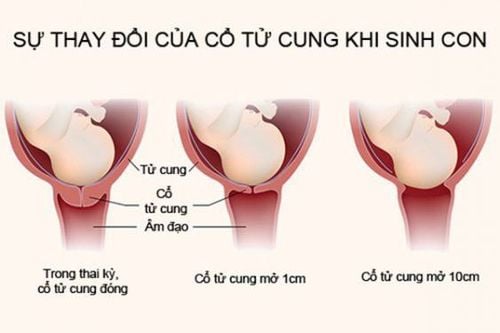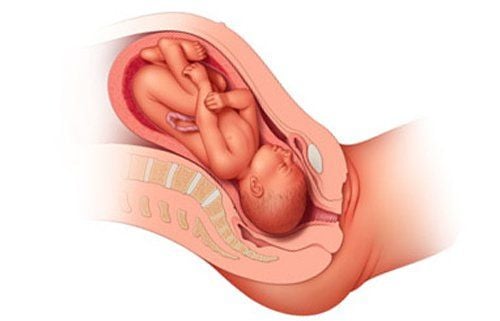This is an automatically translated article.
The article was professionally consulted by Specialist Doctor II Pham Thi Tuyet Mai - Obstetrician and Gynecologist - Department of Obstetrics and Gynecology - Vinmec Hai Phong International General Hospital.Labor-inducing amniotomy is a procedure that releases hormones that cause uterine contractions. However, this method is uncomfortable for pregnant mothers, and many studies disagree with it because of its risks.
1. What is invasive labor?
Labor is when there are short, frequent contractions of the uterus. Contractions occur when the uterine muscles contract and then relax again. Labor helps push the baby out of the uterus and helps the cervix dilate. The cervix is the opening of the uterus located at the top of the vagina. The baby will pass through the cervix into the vagina during delivery.
When pregnant mothers have health problems that can harm themselves and the baby, or the mother is more than 42 weeks pregnant, then the doctor may recommend an interventional labor. For some women, intervention is the best way to keep mother and baby healthy.
Instances that require intervention include:
A pregnancy that lasts longer than 42 weeks. The placenta develops in the uterus and delivers food and oxygen to the baby through the umbilical cord. After 42 weeks of pregnancy, the placenta usually stops working and the baby will no longer be healthy. The placenta gradually separates from the uterus, leading to placental failure and not ensuring enough nourishment for the baby. The mother has an infection in the uterus. The woman has broken or depleted amniotic fluid but no uterine contractions. Pregnant women have health problems, for example: diabetes, high blood pressure, ... can harm themselves and the baby. The fetus has growth problems. The mother is a carrier of Rh (-) blood group.

Trắc nghiệm: Dấu hiệu cảnh báo chuyển dạ thực sự
Chuyển dạ là quá trình thai phụ bước vào giai đoạn “đẻ đau” để kết thúc thời gian “mang nặng”. Thời gian và dấu hiệu chuyển dạ sẽ khác nhau tùy vào vào từng người và nhiều yếu tố. Theo dõi bài trắc nghiệm dưới đây sẽ giúp bạn hiểu rõ hơn các dấu hiệu chuyển dạ một cách chính xác và an toàn.2. Amniotic fluid separation method induces labor
The amniotic sac is the pouch that holds the growing baby inside the uterus. The amniotic sac contains a lot of amniotic fluid.
Separation of the amniotic membrane, also known as amniotic fluid removal from the uterine wall, is an interventional procedure to induce labor. When separating the amniotic membranes, the doctor will put on gloves and gently insert his fingers into the cervix, then slowly separate the amniotic membranes from the uterus.
After the membranes are separated, mothers can go home and wait for contractions to appear. Besides, mothers may also feel abdominal cramps and blood spots. Because in the last weeks of pregnancy, the cervix leans behind the tailbone, making it difficult for the surgeon to reach.
Interventional labor can take a few hours or last 2-3 days, it depends on how each person's body responds to the treatment. If you are in your first pregnancy or are less than 37 weeks pregnant, invasive labor will take longer.
The method of separation of amniotic fluid induces labor only with the consent of the mother. As this procedure is an unnatural method of labour, there are certain risks involved. Before the procedure, the pregnant woman will be provided with basic information, how to perform and the complications related to amniotic membrane separation by the doctor.
3. The risks of interventional labor

There are many studies that do not agree that amniotic membrane separation induces labor due to its many risks. The risks of amniotomy intervention to induce labor include:
High risk of cesarean section: If the intervention is not effective, the doctor will appoint a cesarean section. Requires a lot of pain relievers. Labor interventions can cause contractions to be stronger and more continuous than spontaneous labor. Therefore, it is more likely that the woman will need an epidural or some other medicine to control the pain. Increased risk of infection for both mother and baby Can rupture the amniotic sac and lead to infection if a woman does not deliver within a day or two after the intervention. Causes health problems for the baby: Mothers who use labor interventions will often give birth a little early, between 37 and 39 weeks. Therefore, the baby when born with breathing and other problems In summary, amniotic membrane separation is an interventional method of inducing labor. Interventional labor is only indicated in cases where the mother or baby has health problems that need to be delivered early, and is performed with the consent of the mother. However, amniotic membrane separation can carry many risks, so it is best for mothers to let labor go naturally when the fetus develops normally.
At Vinmec International General Hospital, pregnant women will be examined and consulted carefully to detect early signs of labor. During labor, pregnant women will be monitored and cared for according to standard procedures and protocols, especially relatives will be allowed to enter the delivery room to accompany the mother. In addition, the clinic and delivery room are always fully equipped with fetal heart monitors and have an oxygen system available to immediately supply to the mother when needed.
Please dial HOTLINE for more information or register for an appointment HERE. Download MyVinmec app to make appointments faster and to manage your bookings easily.














